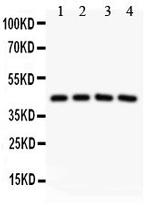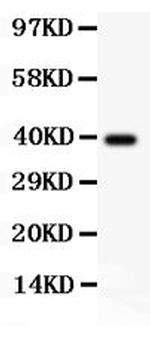Search Thermo Fisher Scientific
FIGURE: 1 / 2
SIRT3 Antibody (PA5-95202) in WB


Product Details
PA5-95202
Species Reactivity
Host/Isotype
Class
Type
Immunogen
Conjugate
Form
Concentration
Purification
Storage buffer
Contains
Storage conditions
Shipping conditions
RRID
Product Specific Information
Human SIRT3 shares 86% amino acid (aa) sequence identity with mouse SIRT3.
Reconstitute with 0.2 mL of distilled water to yield a concentration of 500 µg/mL.
Target Information
SIRT3 is a member of the sirtuin family of proteins, homologs to the yeast Sir2 protein. Members of the sirtuin family are characterized by a sirtuin core domain and grouped into four classes. The functions of human sirtuins have not yet been determined; however, yeast sirtuin proteins are known to regulate epigenetic gene silencing and suppress recombination of rDNA. Studies suggest that the human sirtuins may function as intracellular regulatory proteins with mono-ADP-ribosyltransferase activity. The SIRT3 is included in class I of the sirtuin family.
For Research Use Only. Not for use in diagnostic procedures. Not for resale without express authorization.
References (0)
Bioinformatics
Protein Aliases: HGNC:14931; hSIRT3; mitochondrial nicotinamide adenine dinucleotide-dependent deacetylase; NAD-dependent deacetylase sirtuin-3, mitochondrial; NAD-dependent protein deacetylase sirtuin-3, mitochondrial; Regulatory protein SIR2 homolog 3; silent mating type information regulation 2, S.cerevisiae, homolog 3; sir2-like 3; SIR2-like protein 3; SIRT3L mitochondrial; sirtuin type 3
Gene Aliases: SIR2L3; SIRT3
UniProt ID: (Human) Q9NTG7
Entrez Gene ID: (Human) 23410, (Rat) 293615

Performance Guarantee
If an Invitrogen™ antibody doesn't perform as described on our website or datasheet,we'll replace the product at no cost to you, or provide you with a credit for a future purchase.*
Learn more
We're here to help
Get expert recommendations for common problems or connect directly with an on staff expert for technical assistance related to applications, equipment and general product use.
Contact tech support
